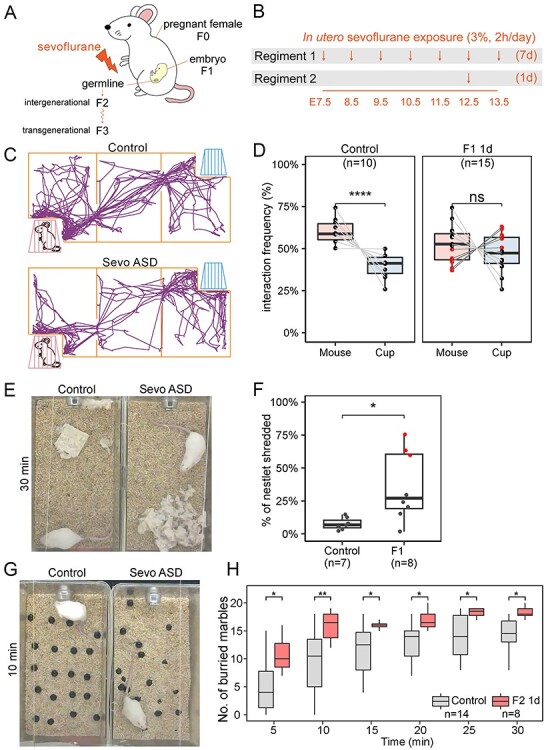Figure 1 .

In utero exposure to sevoflurane during brain development results in ASD-like phenotypes. (A) Diagram of sevoflurane exposure in utero and possible effects on subsequent generations. (B) Diagram of the two exposure regiments utilized in the experiments. One regiment involves daily 2-h exposures for 7 days starting at E7.5 and ending at E13.5. A second regiment involves a single 2-h exposure at E12.5. (C) Schematic representation of the three-chamber sociability test with a typical example of the movements of a control and a sevoflurane-exposed ASD mouse (Sevo ASD). (D) Results from the sociability test in F1 male mice exposed to sevoflurane using the 1-day regiment. Control male mice (n = 10) prefer the chamber housing an unfamiliar stranger mouse (one-way ANOVA, P < 0.0001), whereas F1 mice (n = 15) show no statistically significant differences in their preference for the empty cup or the unfamiliar mouse. Red dots represent mice with sociability index (SI) < 0 and ASD phenotypes, whereas black dots represent mice with sociability index (SI) > 0 and normal phenotypes. (E) Photographs of control and sevoflurane ASD animals at the end of the nestlet shredding test, used to quantify the degree of repetitive and compulsive behaviors, showing differences in shredding behavior between the two. (F) Percentage of shredded nestlet (y-axis) showing the distribution of nestlet shredding for control (n = 7), and F1 male mice exposed using the 1-day regiment. Extreme outliers are marked in red, indicating individuals with ASD-like behavior (one-way ANOVA, *P < 0.05). (G) Pictures of control and sevoflurane ASD animals after 10 min of the marble burying test showing the number of marbles buried by each mouse. (H) Results from the marble burying tests conducted with control and F1 mice exposed to sevoflurane using the 1-day regiment. The x-axis indicates time passed since the beginning of the test (one-way ANOVA; **P < 0.01, *P < 0.05).
